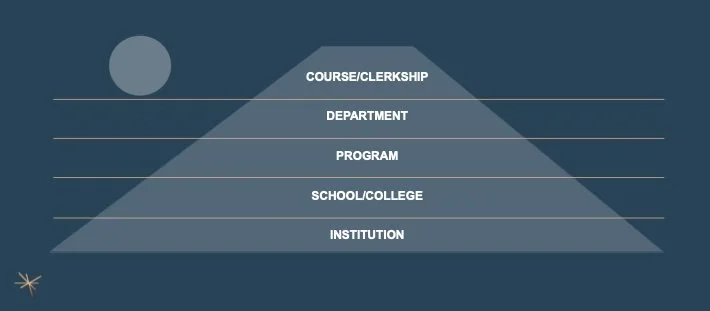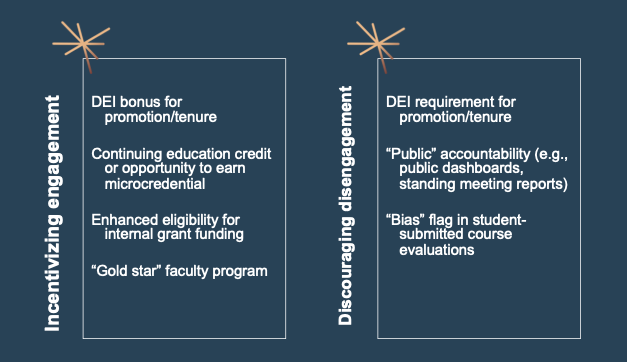Support for Implementing the Checklist in My Program or at My Institution
Programs and institutions are encouraged to adapt the Bias Checklist to suit their needs. The Checklist itself can be downloaded and modified through the REDCap Shared Library; the REDCap files are also available here. If your institution does not participate in REDCap, please email biaschecklist@gmail.com about creating a Friends of Upstate REDCap account and a REDCap project with the checklist for your institution, which will give you both the ability to edit the Checklist and access to data from your institution’s users.
I want to make the case to my administration for using the Checklist →
I want to offer professional development regarding the Checklist to educators at my institution →
I want to make the case to my administration for using the Checklist
The following video presents a brief “elevator pitch” for the importance of mitigating bias in healthcare. We encourage you to adapt it to meet your needs.
“What Is Bias and Why Is It a Problem?”:
Key references from the video:
Tsai J, Ucik L, Baldwin N, Hasslinger C, George P. Race matters? Examining and rethinking race portrayal in preclinical medical education. Academic Medicine. 2016;91(7):916-20. https://journals.lww.com/academicmedicine/fulltext/2016/07000/Race_Matters__Examining_and_Rethinking_Race.14.aspx
Hoffman KM, Trawalter S, Axt JR, Oliver MN. Racial bias in pain assessment and treatment recommendations, and false beliefs about biological differences between blacks and whites. Proceedings of the National Academy of Sciences. 2016;113(16):4296-301. https://www.pnas.org/doi/full/10.1073/pnas.1516047113
Bias in content costs us.
The following are important considerations in making your case for programmatic or institutional use of the checklist:
What level of implementation is appropriate for your settings? Institutions have successfully started with everything from small pilots (courses, units or small groups of faculty volunteers) to top-down, college-wide requirements. All have advantages and disadvantages.
Levels of programmatic and institutional implementation for the Bias Checklist.
What type of implementation is most likely to be effective in your setting? While the Bias Checklist was originally designed for self-assessment and most users are assessing their own content, some institutions have used other models, including peer review, review by course directors, or program-wide task forces or committees charged with systematically reviewing content. As with the level of implementation, there are advantages and disadvantages to each.
Who will compose your team? At a minimum, you will need a Bias Checklist lead or site principal investigator and support from the person in charge of the unit of implementation (e.g., course director, associate dean for the program). Self-assessment approaches require more investment to generate buy-in among potential users and provide training and support, while task forces or committees require more dedicated personnel. Other key roles include support for data collection, analysis and program evaluation and local content experts to help users make changes (see the Domain 101 pages for national experts willing to be contacted).
Who do you need to support programmatic or institutional implementation of the Bias Checklist?
Will you include learners in your team? Although one of the intentions of the Bias Checklist is to alleviate the burden on learners, especially learners from minoritized backgrounds, there are situations and settings in which learner engagement on Bias Checklist implementation is appropriate, necessary and impactful. Notably, students at Tulane University have led the way in bringing the Bias Checklist to their school. We encourage anyone considering including learners to take care to assure that their time is valued and compensated fairly, and that learners are protected from any potential negative repercussions of this work.
How will you create buy-in? Considering your setting, where are the target users of the Bias Checklist in their journeys to understanding concepts like systemic racism? Are users highly motivated or do they need to be incentivized to engage in this type of work? What barriers do you anticipate? Data from a pilot study in a psychiatry clerkship indicates that, on average, a medical school faculty member can review one hour in content in approximately eight minutes.
Carrots, sticks or both? Ways to incentivize engagement with the Bias Checklist and to discourage disengagement.
What barriers do you anticipate and how will you overcome them? The video below addresses some common barriers to implementing the Bias Checklist at the programmatic or institutional level and potential strategies to address these barriers:
Some institutions have also tried to mitigate barriers by starting with only one or two domains of the Bias Checklist. We have hesitated to support that approach because it can mask the realities of intersectionality and contribute to the silo-ing of these issues; however, we will share more data on this approach when it is available.
What resources or budgetary support do you need? One of the goals of the Bias Checklist Collaborative and this website is to make the required resources free and easily accessible. Protected time for the work related to implementing the Bias Checklist, including providing professional development, supporting users—especially in making content changes—and evaluating the impact of the Checklist is likely to be the #1 budget consideration. Additional resources include access to data capture platform like REDCap (in which the public version of the Bias Checklist is housed) or Qualtrics.
Does my institution support REDCap? Find out here: https://projectredcap.org/partners/
Should I use REDCap? You can learn more about REDCap here: https://projectredcap.org/resources/videos/. While it has some limitations, the ease of downloading the Checklist directly from the Shared Library may outweigh the advantages of any other platform.
How will you assess the success of your implementation and its impact? What are your outcomes of interest? Do you already have baseline data or do you need to collect it? You will need a way to determine checklist use or uptake, and you may be interested in other metrics as well. Learner perceptions can be useful but as checklist implementation often goes hand-in-hand with other institutional efforts, increased awareness may initially lead to more concerns being reported.
A decision tree and sample policy for assessing checklist utilization is available as a Google Doc here: http://tinyurl.com/biaschecklistimplementation, or for download here.
Additional resources:
I want to offer professional development regarding the Checklist to educators at my institution
Below are some considerations when offering professional development for educators at your institution:
What are your goals? Is this the first step to piloting the Bias Checklist in a course or degree program? Is the Checklist going to adopted widely? Or is this part of a larger effort or series of programming to promote diversity, equity, inclusion and belonging?
Who is your audience? Some institutions have offered institution-wide, trans-disciplinary and interprofessional development; others have focused on a select group, such as participants in a medical educator development program or faculty in a particular course or unit. Your other decisions will also depend on whether you anticipate hundreds of participants, just five to ten, or somewhere in-between
How “ready” is your audience? You will want to start in a different place for a group of educators with significant previous exposure to DEIB, while an interactive, hands-on workshop might not appropriate if many participants will be skeptical and questioning the impact of bias in healthcare. When attendance is wholly voluntary and not incentivized, audience expertise and “buy-in” tend to be high.
Lecture or interactive workshop? We have offered professional development in numerous formats, including 10-20 minute talks embedded into standing meetings; 45- to 75- minute lectures for large audiences; and 90-minute to 3-hour workshops for smaller groups. Lectures can typically reach larger audiences, while workshops are more resource-intensive. The optimal size for breakout groups in workshops is 4 to 8 participants, depending on goals and preparation.
Facilitators for workshops? We have run workshops with three configurations of facilitators: facilitated by expert faculty from the Bias Checklist Collaborative; facilitated by local faculty leaders and champions with expertise in diversity, equity and inclusion; and self-facilitated (each breakout group has instructions to follow; the workshop leader may float between groups to answer questions).
Single session or series? Some programs have opted for an initial lecture, with an interactive follow-up workshop, series or workshops or Q&A session a few weeks or months later. This allows participants to try out the Bias Checklist in their own work and then ask questions.
Pre- or post-work? Some programs have assigned videos (including those available in the Bias Checklist Collaborative Video Library) or readings, or have asked participants to come prepared with their own content for assessment. Others have had participants evaluate their content post-session, using the Checklist, and complete a reflection.
Below are resources to help you develop and run your own professional development. As with the Bias Checklist itself, these are free tools that you can modify as needed; please credit the Bias Checklist Collaborative in your programming. Please also note that the some of content of these slide decks duplicates content found in the Video Library.
Slide deck for 50-minute introductory lecture
Download as a PowerPoint presentation
Link to Google Slides: https://tinyurl.com/biaschecklist-slidedeck1
Slide deck for 2-hour introductory workshop
Download as a PowerPoint presentation
Link to Google Slides: https://tinyurl.com/biaschecklist-slidedeck2
Template for facilitators’ guide for workshops
Download as a Word document
Link to Google Doc: https://tinyurl.com/biaschecklistfacilitatorsguide
→ Contact us to discuss scheduling a talk!
“This seminar was one of the best seminars I have attended in a long time. The speaker was not only extremely knowledgeable about the topic, but provided the audience with clear, actionable advice.”




